PickYourOwn.org Find a pick-your-own farm near you, then learn how to can and freeze!
- Home
- Start here!
- Correct a listing
- Add a farm
- Feedback comments
- Farmers: add or update your farm
- Search
- Email this page to others

PickYourOwn.org Find a pick-your-own farm near you, then learn how to can and freeze!

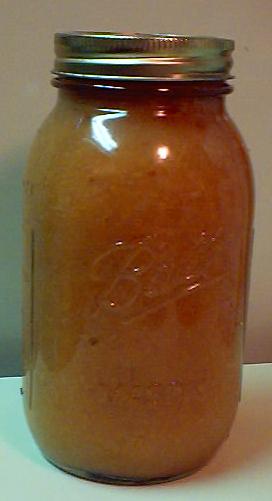 You think making and canning your own homemade applesauce is difficult or
expensive? Not at all! Here's how to do it, complete instructions in easy
steps and completely illustrated. The applesauce will taste much, MUCH
better than anything you've ever had from a store, and by selecting the
right apples, it will be so naturally-sweet that you won't need to add any
sugar at all.
Plus, there is no need for any additives, preservatives or
chemicals.
You think making and canning your own homemade applesauce is difficult or
expensive? Not at all! Here's how to do it, complete instructions in easy
steps and completely illustrated. The applesauce will taste much, MUCH
better than anything you've ever had from a store, and by selecting the
right apples, it will be so naturally-sweet that you won't need to add any
sugar at all.
Plus, there is no need for any additives, preservatives or
chemicals.
Prepared this way, the applesauce jars have a shelf life at room temperature of 2 to 3 years, and require no special attention. And of course, you can freeze the applesauce instead (it keeps indefinitely in a good freezer).
I learned years ago how to make jam and applesauce watching my mother and grandmother when I was a child. My grandmother and mother always made it, and now if I want it, I've got to make it myself (funny how that growing up stuff works?)
UPDATE for Fall 2013: the plentiful rain in many apple-growing regions resulted in the apple crop being about 13% higher (see this page for details), so prices should be the same or possibly a little lower than last year. Advice: check our chart to see when your favorite varieties will be ripe,and call your local orchard to confirm, so you don't miss them!
And here's how you can (or in the UK, "bottle") it too. If you don't want to can the applesauce, but just want some fresh for a meal; or you don't have any food mill, food sieve, etc. see how to make applesauce for a meal (not bottling it) with NO special equipment. And once you've made the apple sauce, why not take some of it and make apple butter? If you'd rather make pear sauce, see this page! Finally, if you want to make chuncky applesauce, see this page.
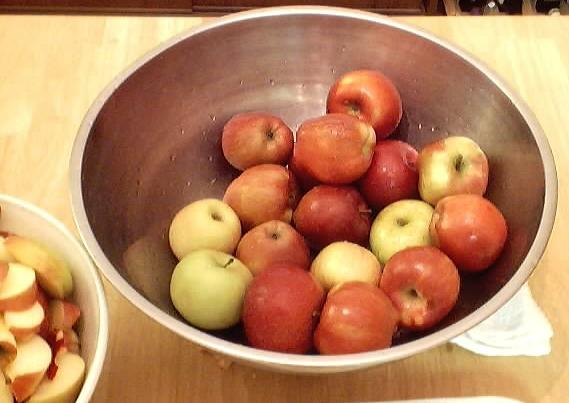 Step
1 - Selecting the apples
Step
1 - Selecting the applesThe most important step! You need apples that are sweet - NOT something like Granny Smith's. Yeah, I know you like them (why do sweet women like sour apples???) and even if I did, they still wouldn't make good applesauce - you'd have to add a lot of sugar.
Instead, choose apples that are naturally sweet, like Red Delicious, Gala, Fuji, Winesap, McIntosh, Yellow Delicious, Mutsu and always use a mixture - never just one type. This year (2025) I used a mixture of Fuji (40%), Gala (35%), Red Delicious (20%) and Yellow Delicious (5%). If I could have found some STayman Winesap, McIntosh or Cameo, I would have added them, too. It was so sweet I did not need to add any sugar at all. And the flavor is great! The Fuji's and Gala's give it an aromatic flavor! Honeycrisp and Pink Lady are also excellent, sweet, flavorful apples (but a bit watery).
"Seconds", "Culls" and "Drops"
Another important tip at orchards is to ask for "seconds", "culls" or "drops". These are smaller apples, sometimes odd shapes or with imperfect appearance. But there're perfect for applesauce and apple butter and uses cost 1/3 to 1/2 the price of the top grade apples. They're usually kept in the back, so you will have to ask for them. They also go quickly, so you may want to call ahead in the day to have some set aside for you. Not all orchards offer "seconds", nut they're a bargain when you can get them!
You can pick your own, or buy them at the grocery store. But for large quantities, you'll find that real* farmer's markets, like the Farmer's Market in Forest Park, Georgia have them at the best prices. Last year, they were available from late September at $15 to $24 per bushel. Prices this year have been in the $18 to $30 range, most were $25/bushel at the real farmer's markets, like the Atlanta-Forest park Georgia State Farmer's Market and orchards in the southeast of the U.S. Weather and crop conditions affect the prices greatly from year to year.
You'll get about 12 to 16 quarts of applesauce per bushel of apples. Count on 12 or 13 quarts per bushel.
* - not the cutesy, fake farmer's markets that are just warehouse grocery stores that call themselves farmer's markets.
 Step
3 - Wash the jars and lids
Step
3 - Wash the jars and lidsNow's a good time to get the jars ready, so you won't be rushed later. The dishwasher is fine for the jars; especially if it has a "sanitize" cycle, the water bath processing will sanitize them as well as the contents! If you don't have a dishwasher with a sanitize cycle, you can wash the containers in hot, soapy water and rinse, then sanitize the jars by boiling them 10 minutes, and keep the jars in hot water until they are used. Leave the jars in the dishwasher on "heated dry" until you are ready to use them. Keeping them hot will prevent the jars from breaking when you fill them with the hot applesauce.
Put the lids into a pan of hot, but not quite boiling water (that's what the manufacturer's recommend) for 10 minutes, and use the magnetic "lid lifter wand" to pull them out.
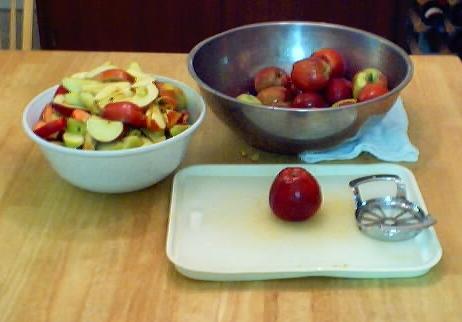 Step
4 -Wash and chop the apples!
Step
4 -Wash and chop the apples!I'm sure you can figure out how to wash the apples in plain cold water.
Chopping them is much faster if you use one of those apple corer/segmenters - you just push it down on an apple and it cuts it into segments. Note: You do not peel the apples! You will put the entire apple into the pot to cook.
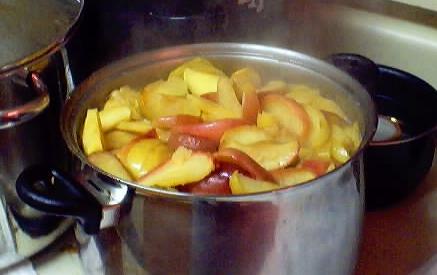 Step
5 - Cook the Apples
Step
5 - Cook the ApplesPretty simple put about 1 inch of water (I used either filtered tap
water or store brand apple juice) on the bottom of a huge, thick-bottome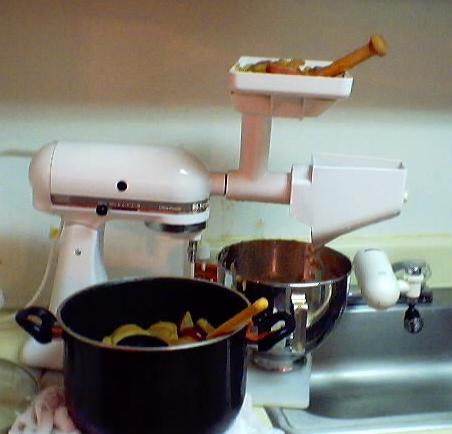 d
pot. Put the lid on, and the heat on high. When it gets really
going, turn it to medium high until the apples are soft through and
through.
d
pot. Put the lid on, and the heat on high. When it gets really
going, turn it to medium high until the apples are soft through and
through.
NOTE: if there is a lot of standing water (juice) among the cooked apples, you may want to ladle it off before you seive the applesauce, or your applesauce may be too watery. Be sure to save and refrigerate the juice - that is tasty natural apple juice! You can use it to cook the next batch of cut apples, or drink it!
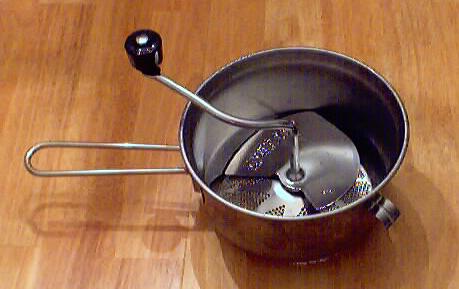
There are several ways to squish the apples through a sieve, either through a :
I found a pretty good deal (about half price) on remanufactured KitchenAid's with a 1 year warranty - see the links above.
You CAN also use a simple metal sieve, but it will be VERY tedious, hard work - if you plan on making applesauce every year, spring for the 25 bucks for the foodmill.
Basically, you put the cooked apples (including the skins, seeds, cores and stems) into the top hopper, and use the wooden plunger to push it in.
 You
CAN make applesauce without a food processor or a $25 foodmill, but it's
much more work, and really only suitable for making a quart or two of
applesauce at a time... but it can be done - click here for the directions on making applesauce with NO special
equipment
You
CAN make applesauce without a food processor or a $25 foodmill, but it's
much more work, and really only suitable for making a quart or two of
applesauce at a time... but it can be done - click here for the directions on making applesauce with NO special
equipment
The device pushes it against a sieve and the applesauce comes
out underneath (in the chrome pot in the photo at left ), and the debris
shoots out the side into the sink - see photo below.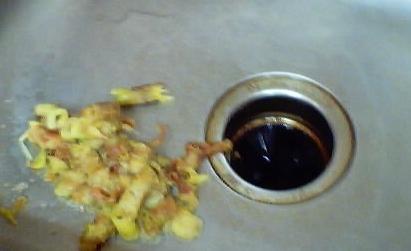
 If
the idea of shelling out about $200 for KitchenAid, plus the additional
$120 for the grinder / sieve attachment doesn't appeal to you, you can still
make applesauce using a Foley Food Mill, pictured at right. You can order
one here for much less than I've seen them elsewhere (see the link below the
picture at right and click for more info). Obviously, you have to crank it
by hand, which is ok if you have child labor and aren't making a lot. If
you are only making a dozen or two jars or don't have other uses for a
KitchenAid, then this is a practical alternative.
If
the idea of shelling out about $200 for KitchenAid, plus the additional
$120 for the grinder / sieve attachment doesn't appeal to you, you can still
make applesauce using a Foley Food Mill, pictured at right. You can order
one here for much less than I've seen them elsewhere (see the link below the
picture at right and click for more info). Obviously, you have to crank it
by hand, which is ok if you have child labor and aren't making a lot. If
you are only making a dozen or two jars or don't have other uses for a
KitchenAid, then this is a practical alternative.
There is also a VERY nice, versatile strainer pictured at far right! Click on the links there or see the bottom of this page for more information and to order! The VillaWare model can handle higher volumes than a Foley food mill (without giving you cramps!)
To see a greater variety of strainers in other types, sizes, and prices, click here!
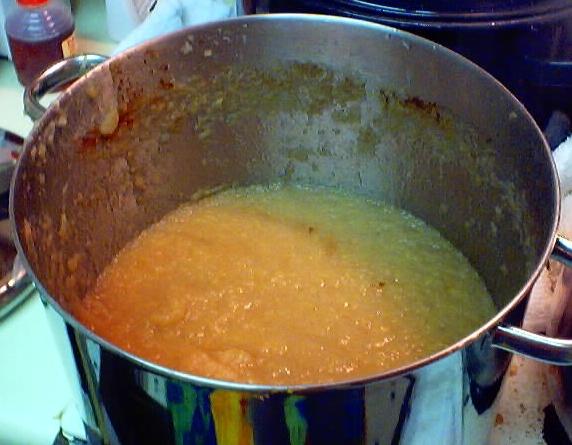 Step
7 - Season and keep the applesauce hot
Step
7 - Season and keep the applesauce hotPut the applesauce into a large pot. Add cinnamon to taste. You should not need to add any sugar.
The applesauce does not need any further cooking; just keep it hot until you get enough made to fill the jars you will put into the canner (Canners hold seven jars at once, whether they are quart or pint size)
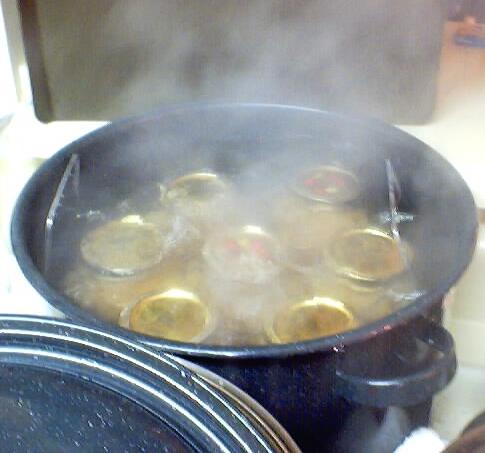 Step
8 - Fill the jars and process them in the water bath
Step
8 - Fill the jars and process them in the water bathFill them to within 1/4-inch of the top, wipe any spilled applesauce of
the top, seat the lid and gently tighten the ring around them. Put
them in the canner and keep them covered with at least 1 inch of water.
Get the canner back to a full boil and begin timing. If you are at sea
level (up to 1,000 ft) boil pint jars for 15 minutes and quart jars for 20
min. If you are at an altitude of 1,000 feet or more, see the chart
below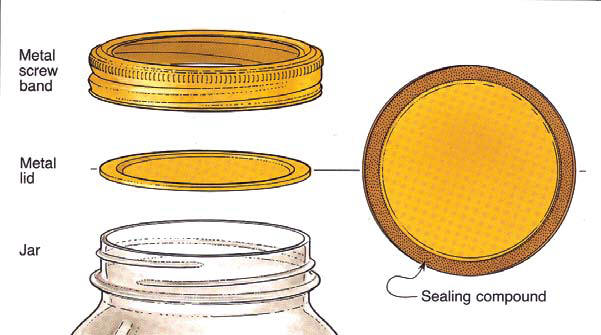
.
|
Recommended process
time for applesauce in a |
||||
| Process Time at Altitudes of | ||||
| Quart Size | 0 - 1,000 ft | 1,001 - 3,000 ft | 3,001 - 6,000 ft | Above 6,000 ft |
| Pints | 15 min | 20 | 20 | 25 |
| Quarts | 20 | 25 | 30 | 35 |
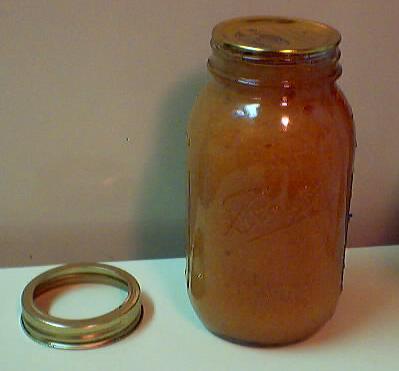 Step
9 - Remove and cool the jars - Done
Step
9 - Remove and cool the jars - Done
 Lift
the jars out of the water and let them cool without touching or bumping
them in a draft-free place (usually takes overnight) You can then
remove the rings if you like, but if you leave them on, at least loosen
them quite a bit, so they don't rust in place due to trapped moisture.
Once the jars are cool, you can check that they are sealed verifying
that the lid has been sucked down. Just press in the center, gently,
with your finger. If it pops up and down (often making a popping sound),
it is not sealed. If you put the jar in the refrigerator right away, you
can still use it. Some people replace the lid and reprocess the jar,
then that's a bit iffy. If you heat the contents back up, re-jar them
(with a new lid) and the full time in the canner, it's usually ok.
Lift
the jars out of the water and let them cool without touching or bumping
them in a draft-free place (usually takes overnight) You can then
remove the rings if you like, but if you leave them on, at least loosen
them quite a bit, so they don't rust in place due to trapped moisture.
Once the jars are cool, you can check that they are sealed verifying
that the lid has been sucked down. Just press in the center, gently,
with your finger. If it pops up and down (often making a popping sound),
it is not sealed. If you put the jar in the refrigerator right away, you
can still use it. Some people replace the lid and reprocess the jar,
then that's a bit iffy. If you heat the contents back up, re-jar them
(with a new lid) and the full time in the canner, it's usually ok.
Summary - Cost of Making Homemade Applesauce - makes 14 quarts* |
||||
| Item | Quantity | Cost in 2025 | Source | Subtotal |
| apples | 1 bushel (about 42 lbs) |
Depends on the apples you choose: as low as $10/bushel for "seconds" to $28/bushel for Fuji's at a farm market. A good average price is $20/bushel | Pick your own | $20.00 |
| Canning jars (quart size), includes lids and rings | 14 jars | $9.00/dozen quart jars | Grocery stores, like Public, Kroger, Safeway and sometimes, Big Lots, local hardware stores and big box stores | $9.33 |
| Cinnamon | 1 tablespoon | $0.25 | Grocery stores, like Public, Kroger, Safeway and sometimes, Big Lots, local hardware stores and big box stores | $0.25 |
| Total | $29.58 total or about $2.11 per jar (including the jars - or $1.54 per quart if you already have the jars and just buy new lids) and as low as 75 cents per jar if you use "seconds" apples and have reuse your jars! |
|||
| * - This assumes you already have the pots, pans, ladles, and reusable equipment. Note that you can reuse the jars! abcxyz123. | ||||
Q. Can I use a JuiceMan or Vitamix instead of the grinder/sieve? The Juiceman will 'spit out' the pulp and seeds, but the Vitamix uses everything. This is my first time making applesauce and I really don't want to mess it all up.
A. It sounds like the Vitamax isn't appropriate: I'm not sure many people want to eat ground up stems and cores. In my humble opinion, that's carrying "eat some fiber" to an extreme! :) And it would mostly likely adversely affect the taste, plus the seeds contain small amounts of cyanide (see this page for more information.)
The Juiceman might work. If it ejects the seeds, stems and hard parts of the core, while allowing the edible apple pulp to pass through, that's what you want.
Since it appears to be designed to "juice" fruit, the applesauce might be ultra-smooth; which could be either a positive or a negative, depending upon your preferences.
Finally, the inclusion of skins in the final product is debatable. The naturalists (hmm, and frugal folks, too) will argue that the skins could and should be ground up and included, as that increases the yield of the applesauce and that's "where the nutrition is" (a statement that I haven't yet seen from credible source, like a major university food science lab). Of course, if any fungicides or pesticides are used, they concentrate in the skin (remember the controversy over Alar?)
If the apples are grown without the use of pesticides or fungicides, then the only concern is the taste, but who knows, you may prefer it with the skins ground in. You don't know till you try!
Q. Can I use a blender for making apple sauce instead of a food mill or food processor?
Certainly! Of course, you'll need to peel, cut, core and manually remove the seeds first, before you cook the apples; unless you want them all blended up into the applesauce. I get letters from people say they prefer it that way. I think I'll keep using the strainer.. But sure, aside from the extra work in preparation , you can use the blender.
Q. I was wondering if the applesauce recipe could be frozen and then used?
Yes, absolutely! There's not much difference in flavor, applesauce cans very well, so most people can it rather than freeze, because of space limitations in their freezer. In a good deep freeze, it should easily last a year. Just let it cool to room temperature, pour it into Ziploc bags or other suitable freezer containers and pop it in the freezer! That's all there is to it!
Q. I have a question about canning applesauce. Some of mine bubbled over
in the canner.
The lids made a good seal, however. I wanted to know if I can
consider these canned or do I have to keep them in the fridge?
Since they sealed and they were processed in the water bath, they should be fine! It sounds like the jars were filled too full (not enough headspace) or allowed to cool between filling and putting them in the hot water bath.
Q. Have you heard of strawberry-applesauce? Can it be "canned" at home?
Yes, I have made it fresh. I have not found a lab-tested USDA or University sanctioned recipe for strawberry applesauce, but since both strawberries and apples are acidic, safe to can in a water bath canner, high sugar, and pureed, I'd have to believe that a mix of the two would be equally safe. Understand, this is just my layman's estimation, not based on a lab test. If I were to can it, I'd use the recipe above and simply replace and 20% of the apples with strawberries, adding the hulled whole strawberries in with the chopped apples in step 5.
Q. I made and water bathed my applesauce about 3 weeks ago. Did everything that I was told to do. But, my applesauce is turning kind of brown on the very top of the bottle. Is this a problem?"
Not at all; that's fairly normal. It's just a bit of surface oxidation. It usually only discolors the top 1/4 inch or so of applesauce. It's harmless and won't affect the taste. Next year, just leave a little bit less headspace, make sure your water bath is really boiling hard, and if it bothers you, sprinkle a little bit of "Fruit Fresh" (available at most grocery stores; it's a citric acid/ascorbic acid mix) on the top of each jar, after you fill it, but (obviously) before you put the lids on.
Q. Hello, I made applesauce and canned for the very first time last week. I put the boiling applesauce in the jars and sat the jars on the counter and they sealed on their own. I did not know I was suppose to use a water canner or pressure cooker. Now that I have done more research I know that I should have used a water canner. Is all of my applesauce fine since it all the lids sealed or should I be worried? '
Well, the USDA and universities will argue that it was not sterile, and is risky. The sealing was due merely to the cooling of expanded heated water, but is completely unrelated from any assurance of a sterile condition. I think you will find that the rate of spoilage could be high compared with water bath processed jars of applesauce.
The risk of botulism still exists. And since botulism spoilage has no taste, color, odor or gas, it is undetectable at home.
In short, I'm afraid that there is no answer without lab testing your jars. Some families routinely can without processing, but I don't think I'd take the risk. See this page for more information.
Q. Thickening runny applesauce: "I have been adding apples to a stockpot of applesauce that I have been making, today was the third time reheated and I was going to can it today and the sauce started becoming runnier and runnier. I have done this before without issues but used a different kind of apple. Have I ruined it for sauce now? Can it be salvaged for something else like apple butter if I have? There is 3 different types of apples in this batch
Well, thanks to the plentiful rainfall this year, most apples are a bit more watery than in past years. You could also be using apple varieties that are especially watery, like Honeycrisp, Pink lady, Gala. In that case, to get a thicker apple sauce. It sounds like you are not using a food mill or sieve, but are peeling and coring the apples and coking them directly into applesauce. You have a couple of options. You can either
1. core and peel a drier variety (like Fuji, Rome Beauty) and add that, or
2. peel, core and segment your apples, cook them (apart of the too-thin applesauce) until soft in a 1 inch of water. Then drain off the liquid and add the solids to your applesauce. The liquid makes good drinking apple juice.
Of course, cooking the unpeel chopped apples and then using the food mill gives you the ability to ladle off excess juice before your mush and sieve the apples. Foley food mills (see on the applesauce instructions page) are usually about $24 and well worth the investment.
And yes, you could always use the applesauce to make apple butter!
Here's what some visitors had to say:
Home Canning KitsThis is the same type of standard canner that my grandmother used to
make everything from applesauce to jams and jellies to tomato and
spaghetti sauce. This complete kit includes everything you need and lasts
for years: the canner, jar rack, jar grabber tongs, lid lifting wand, a
plastic funnel, labels, bubble freer, and the bible of canning, the Ball
Blue Book. It's much cheaper than buying the items separately. You'll
never need anything else except jars & lids (and the jars are reusable)!
There is also a simple kit with just the canner and rack, and a pressure canner, if you want to do vegetables (other than tomatoes). To see
more canners, of different styles, makes and prices, click here! |
|
Victorio V250 Food Strainer (the same as the
comparable Villaware and Roma models)
See the seller's website for more information, features, pricing and user reviews! |
|
Deluxe Food Strainer and Sauce Maker
|